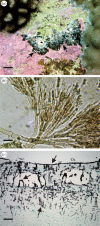Ocean warming and acidification have complex interactive effects on the dynamics of a marine fungal disease
- PMID: 24452029
- PMCID: PMC3906949
- DOI: 10.1098/rspb.2013.3069
Ocean warming and acidification have complex interactive effects on the dynamics of a marine fungal disease
Abstract
Diseases threaten the structure and function of marine ecosystems and are contributing to the global decline of coral reefs. We currently lack an understanding of how climate change stressors, such as ocean acidification (OA) and warming, may simultaneously affect coral reef disease dynamics, particularly diseases threatening key reef-building organisms, for example crustose coralline algae (CCA). Here, we use coralline fungal disease (CFD), a previously described CCA disease from the Pacific, to examine these simultaneous effects using both field observations and experimental manipulations. We identify the associated fungus as belonging to the subphylum Ustilaginomycetes and show linear lesion expansion rates on individual hosts can reach 6.5 mm per day. Further, we demonstrate for the first time, to our knowledge, that ocean-warming events could increase the frequency of CFD outbreaks on coral reefs, but that OA-induced lowering of pH may ameliorate outbreaks by slowing lesion expansion rates on individual hosts. Lowered pH may still reduce overall host survivorship, however, by reducing calcification and facilitating fungal bio-erosion. Such complex, interactive effects between simultaneous extrinsic environmental stressors on disease dynamics are important to consider if we are to accurately predict the response of coral reef communities to future climate change.
Keywords: bio-erosion; climate change; coral reef; coralline fungal disease; ocean acidification; temperature.
Figures




Similar articles
-
Host-associated coral reef microbes respond to the cumulative pressures of ocean warming and ocean acidification.Sci Rep. 2016 Jan 13;6:19324. doi: 10.1038/srep19324. Sci Rep. 2016. PMID: 26758800 Free PMC article.
-
Global declines in coral reef calcium carbonate production under ocean acidification and warming.Proc Natl Acad Sci U S A. 2021 May 25;118(21):e2015265118. doi: 10.1073/pnas.2015265118. Proc Natl Acad Sci U S A. 2021. PMID: 33972407 Free PMC article.
-
Near-future ocean acidification causes differences in microbial associations within diverse coral reef taxa.Environ Microbiol Rep. 2013 Apr;5(2):243-51. doi: 10.1111/1758-2229.12006. Epub 2012 Oct 28. Environ Microbiol Rep. 2013. PMID: 23584968
-
Operationalizing resilience for adaptive coral reef management under global environmental change.Glob Chang Biol. 2015 Jan;21(1):48-61. doi: 10.1111/gcb.12700. Epub 2014 Sep 5. Glob Chang Biol. 2015. PMID: 25196132 Free PMC article. Review.
-
Coral reefs under rapid climate change and ocean acidification.Science. 2007 Dec 14;318(5857):1737-42. doi: 10.1126/science.1152509. Science. 2007. PMID: 18079392 Review.
Cited by
-
The roles of endolithic fungi in bioerosion and disease in marine ecosystems. II. Potential facultatively parasitic anamorphic ascomycetes can cause disease in corals and molluscs.Mycology. 2017 Aug 31;8(3):216-227. doi: 10.1080/21501203.2017.1371802. eCollection 2017. Mycology. 2017. PMID: 30123642 Free PMC article.
-
Effects of climate change on parasites and disease in estuarine and nearshore environments.PLoS Biol. 2020 Nov 24;18(11):e3000743. doi: 10.1371/journal.pbio.3000743. eCollection 2020 Nov. PLoS Biol. 2020. PMID: 33232311 Free PMC article.
-
Histopathology of crustose coralline algae affected by white band and white patch diseases.PeerJ. 2015 Jun 30;3:e1034. doi: 10.7717/peerj.1034. eCollection 2015. PeerJ. 2015. PMID: 26157617 Free PMC article.
-
Expanding our Understanding of the Seaweed Holobiont: RNA Viruses of the Red Alga Delisea pulchra.Front Microbiol. 2016 Jan 8;6:1489. doi: 10.3389/fmicb.2015.01489. eCollection 2015. Front Microbiol. 2016. PMID: 26779145 Free PMC article.
-
The role of coral colony health state in the recovery of lesions.PeerJ. 2016 Jan 5;4:e1531. doi: 10.7717/peerj.1531. eCollection 2016. PeerJ. 2016. PMID: 26788423 Free PMC article.
References
-
- Ward JR, Lafferty KD. 2004. The elusive baseline of marine disease: are diseases in ocean ecosystems increasing? PLoS Biol. 2, 542–547 (doi:10.1371/journal.pbio.0020120) - DOI - PMC - PubMed
-
- Harvell CD, Mitchell CE, Ward JR, Altizer S, Dobson AP, Ostfeld RS, Samuel MD. 2002. Ecology: climate warming and disease risks for terrestrial and marine biota. Science 296, 2158–2162 (doi:10.1126/science.1063699) - DOI - PubMed
-
- Aronson RB, Precht WF. 2001. White-band disease and the changing face of Caribbean coral reefs. Hydrobiologia 460, 25–38 (doi:10.1023/A:1013103928980) - DOI
-
- Bruno JF, Petes LE, Harvell CD, Hettinger A. 2003. Nutrient enrichment can increase the severity of coral diseases. Ecol. Lett. 6, 1056–1061 (doi:10.1046/j.1461-0248.2003.00544.x) - DOI
-
- Bruno JF, Selig ER, Casey KS, Page CA, Willis BL, Harvell CD, Sweatman H, Melendy AM. 2007. Thermal stress and coral cover as drivers of coral disease outbreaks. PLoS Biol. 5, 1220–1227 (doi:10.1371/journal.pbio.0050124) - DOI - PMC - PubMed
Publication types
MeSH terms
LinkOut - more resources
Full Text Sources
Other Literature Sources
Molecular Biology Databases
Miscellaneous

